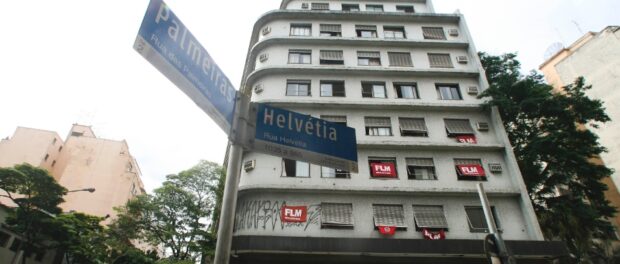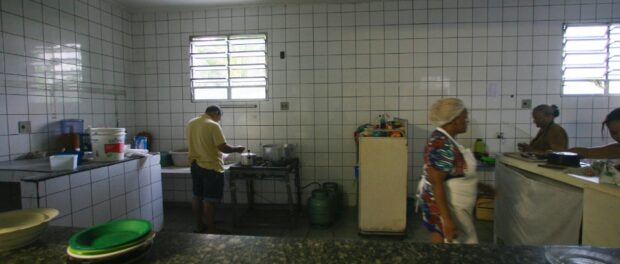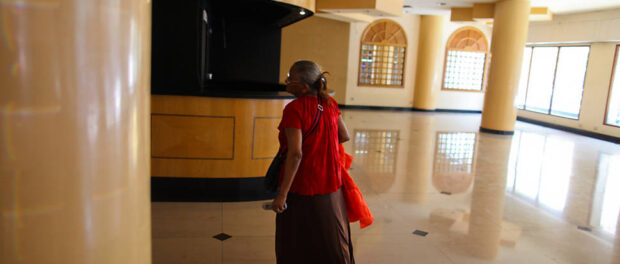
In the center of São Paulo this March, the Fight for Housing Front (FLM) celebrated a major success: the legal rights of ownership to the grandiose building that was formerly the Lord Palace Hotel would be turned over to those who occupied it and have been residing there for almost three and a half years.
The Lord Palace Hotel in the Santa Cecília area of downtown São Paulo sat abandoned for eight years, with a plaque out front stating that anyone occupying it would not receive help from the City government. It had previously been a hotel for the elite, which was then converted into a buffet-by-the-kilo restaurant. The business failed, and the City repossessed the property due to back taxes owed by the former owner. The City built a wall around the building, put up the aforementioned plaque, installed one security guard, and then left the building unused for nearly a decade.
On October 18, 2012, the building took on new life. That night, the FLM coordinated 18 different housing occupations around the city, including the Lord Palace Hotel building. As city resources were stretched thin to respond to so many simultaneous occupations, the occupation took place that night relatively unchallenged. The people who came to occupy told the lone security guard of their plans and asked that he go home, to which he complied. Today, there are 326 families living in the occupation, and 11 people employed by the occupation as doormen, elevator operators, and janitors.
Social Movements Respond to Housing Crisis in São Paulo
Unfortunately, the situation of those who have come to occupy the Lord Palace Hotel is part of a much larger housing crisis in São Paulo. While many of the families who came to occupy the Lord Palace Hotel were previously homeless, according to Guilherme Bolos, national coordinator of the Landless Workers’ Movement (MTST), 95% of people in the housing deficit of 5.8 million in São Paulo are either paying rents that are more than a third of their total income, cohabiting with relatives in cramped conditions as a favor, or living in high-risk situations. The Institute of Urbanism and Metropolis Studies (URBEM) and other groups estimate that by 2024 over 700,000 “first level” low-income housing units (for those earning up to three times the minimum wage) will have to be built to address the housing deficit in the city. As of 2014, the Municipality of São Paulo had plans to build less than half of this.
The FLM is a group of united social movements that came together in 2003 in order to respond to this crisis, and made their union official through a first meeting followed by initial occupations in 2004. Member movements include the Homeless Movement of the Central Region (MSTC), Forum on Housing and the Environment of the State of São Paulo (Fomaesp), Collective Action Forum, Collective Action Association (Associação de Mutirões), Movement of Yards and Tenements of the Mooca Region (Movimento Quintais e Cortiços da Região da Mooca), Our People’s Land Movement (Movimento Terra de Nossa Gente), the Homeless Movement for Urban Reform (Sem-Teto pela Reforma Urbana), and the Housing Movements of the North Zone (Movimento de Moradia da Zona Norte), and of the Center-North Zone (Movimento Centro-Norte).
The movement comes out of a history of community organizing through self-managed mutirões, or collective work sessions, often done to make material upgrades in communities. These mutirões became a government-subsidized strategy in São Paulo during the mid-1980s democratic transition. Many of the movements that act as the foundation for the FLM began in struggles to demand upgrades to existing communities, such as favelas, informal subdivisions (loteamentos), and tenements (cortiços). The São Paulo city government officially began to subsidize these mutirões in 1989 under the Luiza Erundina mayoral administration, providing materials and land. Towards the end of the 1980s, the movement was also inspired by exchange with Uruguay’s housing cooperatives, where over 20,000 families live in housing cooperatives collectively built and owned.
The goals of the FLM are for urban reform that allows for people of all class backgrounds to occupy downtown urban areas, thus “diminishing environmental impacts of horizontal urban expansion.” Another part of their stated mission, which is demonstrably realized in their occupation of the Lord Palace Hotel, is for “the properties of debtors to the country, the state, and the city to be spaces in which to construct low-income housing.” Finally, as they have done in the case of the Lord Palace Hotel, they aim to always incorporate participation and self-managed mutirões.
Occupation in Practice
Maria do Planalto, a 31-year veteran activist with the FLM and an important leader with the role of Social Advisor in the occupation, explains the rationale behind the occupations in simple terms: “Both the Brazilian Constitution and the Bible speak of the right to housing; there are so many vacant buildings that only serve rats and cockroaches, while you have families without homes.” She explains that the families who occupied the former Lord Palace Hotel were homeless and that the occupation took place during a period of heavy rains. While there was an emergency need for housing, she says that the initial goal that night was not necessarily to get the title to this building: “We weren’t so bold to think that we would accomplish that.”
Indeed, other Brazilian social movements for housing that have utilized occupation often emphasize that it is not a long-term strategy. Representatives from the MNLM and the MTST have said that occupations are typically more of a strategy to pressure the government for better housing options than an attempt to create permanent housing by means of the occupation.
The central downtown location of the building also kept occupiers’ expectations tempered. Planalto talks about the prejudices of the neighborhood’s residents who she claims were surprised at the endurance of the occupation, having assumed that the occupiers were disorganized “tramps.” She believes that their permanence challenges notions that “poor people have to live far away” in the periphery, and that “the downtown belongs to the elite.” Planalto says that while not everyone adapts to living in the center, there are undeniable benefits in terms of proximity to employment opportunities, childcare, and more.
Part of what movement leaders believe has made the movement successful is the civic engagement of residents. All residents come from the FLM, from one of 32 base groups spread across the city. Planalto says, “you can’t just pick someone up from the street to participate. It’s not enough to just reside at the occupation.” Each resident has a ficha de participação, or participation card, that tallies their attendance at various activities of the occupation, such as a mutirão, as well as their attendance at movement events.
Another feature that kept the occupation running relatively smoothly is its structured self-organization. Each of the 12 floors of the building has a coordinator, and the coordinators make up a council that deals with day-to-day governance of the building. Planalto explains that the coordinator role is “an art, you have to enjoy it; it can’t be seen as a job.” She stresses that within the council, members seek to keep criticism productive, and not compete. Their responsibilities include interfacing with residents on their floor to understand concerns, and providing guidance when something is not working well, especially with the many children in the building.
In addition to the council, there is an association, whose president is elected by all residents. The association is more responsible for logistical and administrative components, such as accounting. Every Monday, the FLM has a meeting with representatives from all 32 area base groups, as well as from all affiliated movements.
The road has not been easy, though, and there have been multiple threats of eviction from the building. Planalto recounted how, under Mayor Gilberto Kassab, a police captain was sent to inform residents that they would be thrown out on December 23, 2012, two days before Christmas. When the police captain arrived, he was surrounded by many of the occupation’s youngest residents, who wanted to take a photo with the uniformed police captain. Moved by the situation, and also aware of what a media circus throwing out so many young families at that time of year would create, the police captain set a meeting in the new year. However, with the change in mayoral administration (to Mayor Fernando Haddad), confusion led to a temporary suspension of the eviction.
There was one more threat of eviction after this, but the coordinating bodies of the occupation have been stalwart in leading resistance to such threats.
Obtaining Title
The big opportunity came for the Lord Palace Hotel occupation when the City released a call for proposals for Minha Casa Minha Vida-Entidades (MCMV-En), the part of the national Minha Casa Minha Vida housing program that funds self-organized affordable housing initiatives. In many ways, the Entidades program responds to activist critiques of the overall MCMV program: that housing is low-quality, leaves residents indebted, and is located in remote areas without infrastructure or transportation, often overrun by militia. Housing scholars in Brazil, such as Nabil Bonduki, have emphasized the need for participation and self-management in housing projects, and have highlighted how urban occupations espouse these strategies.
The FLM Lord Palace Hotel occupation won the city-wide call for MCMV-En proposals and the building passed into their association’s name on March 17. At present, the FLM occupants are preparing to move out of the building for renovations over the next 14 months. During renovations, residents will pay a contribution, the amount of which they agreed upon in council meetings, going towards the technical assistance in planning the renovation and the 11 current employees.
After the renovations, the FLM as a movement will leave, passing control to a yet-to-be established neighborhood association. 176 of the families who have been most active in movement activities (as measured by the aforementioned ficha de participação) will receive housing. The other 150 families currently residing in the building will continue the active FLM struggle in São Paulo’s East Zone.
The first floor of the building will be redone for commercial use of resident businesses in an example of mixed use housing that is also typical in favelas, and which urban planners point to as smart urban development. Profits from renting these commercial properties will go back into the cooperative, thus subsidizing affordable rent. While renting a typical downtown studio apartment costs about R$1500 per month, in the building family rent will be set at 5% of income, with resident family monthly income caps of R$1800. The City government will pay utility (water and electricity) bills.
Building Community, Expanding Citizenship
The occupation is not only a success in terms of its ability to successfully secure housing for 176 families, but also in building a relatively cohesive community that has supported the more integral needs of the families living there. Planalto cited the discrepancies between rent prices and workers’ salaries and explains that now that these families are not struggling to pay rent or living on the street, they are able to invest in education. She specifically cited Raphael, an Afro-Brazilian boy from a poor background who is now studying at the prestigious University of São Paulo (USP). Planalto explained that Raphael’s achievements are celebrated by the entire community, and that they set an example for younger residents.
The occupation also empowers women, in educational opportunity and beyond. Many middle-aged women residents are returning to school now they have a stable residence in the occupation. Within the movement, Planalto explained, “women come in one way and leave in much better shape… building independence” and learning their rights in the household. She said that many men enter with drinking problems, and that consciousness-raising activities that the movement conducts can be very important for them. She herself was married at sixteen, and says the movement has changed the dynamics in her marriage.
The intersectionality of women’s and housing issues is central to the occupation’s and to FLM’s broader struggle, as it has been for other Brazilian housing movements. Planalto pointed out that women heads of households have to find childcare and work, all while earning less than men. On International Women’s Day on March 8, the FLM led a march for women’s rights where they took participants to different abandoned factories that could be potential sites for occupations.
For Planalto, the proudest moments of this occupation’s struggle have been: when the first child was born in the occupation; when one of the residents was able to return after losing an apartment in public housing; and when the mayor himself had to state publicly that the building belonged to the FLM association that has been coordinating the occupation. The resident who had returned after losing the other apartment told RioOnWatch, the occupation “is a community, it is a family.” With a focus on meeting basic needs, community, education, and political engagement, Planalto says the most important lesson she has taken from her 31 years in the struggle is that “you don’t need money to be happy.”



